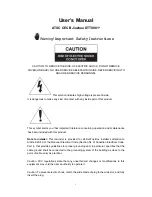
Preparing for use
R&S
®
NRPxxA(N)
15
User Manual 1177.6017.02 ─ 08
180
NRP
3-Path Diode Power Sensor
MHz to GHz, 100 pW to 200 mW (−70 dBm to +23 dBm)
SMART SENSOR TECHNOLOGY
4.
NOTICE!
Risk of damaging the center pin of the RF connector. Only rotate the hex
nut of the RF connector. Never rotate the power sensor itself.
Tighten the RF connector manually.
5. Tighten the RF connector using a torque wrench with the nominal torque recom-
mended in
on page 26 to ensure maximum mea-
surement accuracy.
To disconnect from the DUT
1.
NOTICE!
Risk of damaging the center pin of the RF connector. Only rotate the hex
nut of the RF connector. Never rotate the power sensor itself.
Carefully loosen the union nut at the front of the RF connector of the power sensor.
2. Remove the power sensor.
3.5
Powering the power sensor
The electrical power for the R&S NRPxxA(N) is supplied over one of the following inter-
faces:
●
Host interface
See
●
LAN PoE interface
Available only for LAN power sensors. See
Chapter 4.5, "LAN PoE interface"
If you use the Ethernet interface of the LAN power sensors, you have to provide the
electrical power by power over Ethernet (PoE). In this case, you
cannot
provide the
electrical power over the host interface instead.
Choose the PoE power sourcing equipment (PSE) with care
Only use PoE power sourcing equipment (PSE) as specified in the IEEE standards
802.3af or IEEE 802.3at. Otherwise, the following can happen:
●
If too much power is supplied, the LAN power sensor can get overheated and
become damaged as a result.
●
If the supplied power is not sufficient, the LAN power sensor does not work prop-
erly or not at all.
Powering the power sensor
















































